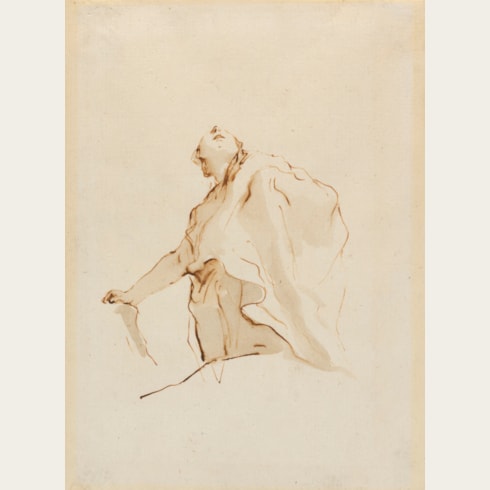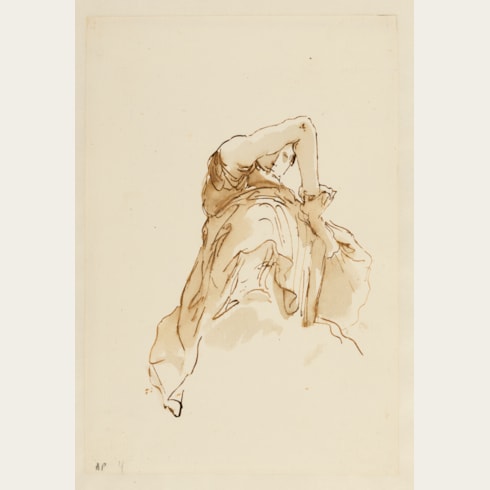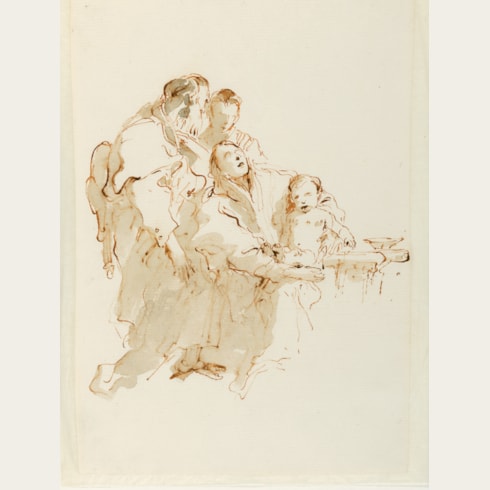Giovanni Battista TIEPOLO
(Venice 1696 - Madrid 1770)
Allegorical Figures of Valour and Fame: The Apotheosis of a Warrior
Inscribed M. Fauchier Magnan / J. B. Tiepolo / Allegorie on a label pasted onto the old backing board.
216 x 289 mm. (8 1/2 x 11 3/8 in.)
The late Tiepolo scholar George Knox related several of these drawings to Tiepolo’s ceiling fresco of an Allegory of Merit Between Nobility and Virtue in one of the rooms of the Ca’ Rezzonico in Venice, painted in the spring of 1757 to celebrate the forthcoming marriage of Ludovico Rezzonico and Faustina Savorgnan, and one of the last major decorative works completed by the artist in Italy before his move to Spain in 1762. As James Byam Shaw has noted of Tiepolo’s drawings of this type, however, ‘there is seldom an exact correspondence with the finished work, so that sometimes it is difficult to decide whether the drawing is a preliminary idea, or a return to an earlier motive.’ As such, some of these drawings may perhaps also be related to a number of other ceiling paintings of analogous subjects. Indeed, as Knox has pointed out, ‘The theme of the apotheosis of the hero recurs often in the Tiepolo oeuvre, both in his painting and in his drawings’, a statement echoed by another recent scholar, who writes that ‘[A] type of figure, where a member of a patrician family is shown with the attributes of Valor, would prove to be one of Tiepolo’s most durable creations.’
A similar laurel-wreathed soldier accompanied by a trumpet-bearing figure of Fame, for example, appears in Tiepolo’s ceiling canvas of The Glorification of the Barbaro Family (or Valour with Virtue and Fame and Other Virtues) of c.1750, painted for the Palazzo Barbaro in Venice and now in the Metropolitan Museum of Art in New York. Other ceiling paintings of similar subjects executed by Tiepolo in the 1750s include a vast Apotheosis of Angelo della Vecchia completed in c.1750 for the Palazzo dei Conti Vecchia in Vicenza and now in the Palazzo Isimbardi in Milan, and a fresco of The Apotheosis of Orazio Porto (or Valour Crowned by Virtue Overcoming Time), painted for the Palazzo Porto in Vicenza in c.1757 and now in the Seattle Art Museum.
As a draughtsman, Tiepolo favoured pen, ink and brush, and the present sheet is a superb example of his abilities. As James Byam Shaw has described the artist’s technique, ‘Often he used a hard black chalk, or a lead point, to indicate first, very roughly, the main character of the composition; then comes the finely cut quill – more rarely a reed – to sketch the forms; and finally a brush, with a tawny bistre or greyish-brown colour, for the shadows. This wash is often the lightest possible, and of a single tone, or varying only according to the fullness of the brush; but often, and especially in more pictorial compositions, there are two distinct tones...strong accents being added with a drier brush, over the lighter and more transparent wash, before this was completely dry...there is a remarkable degree of volume and solidity, which, with his delicate line and apparently casual washes, the artist is able to impart to all his forms.’
The first known owner of the present sheet was the eminent biologist William Bateson, FRS (1861-1926), who owned a choice group of pen and ink drawings by Giambattista Tiepolo. In 1911 Bateson lent this drawing, along with several others by the artist, to the seminal Exhibition of Venetian Painting of the Eighteenth Century at the Burlington Fine Arts Club in London. This drawing, however, does not seem to have been included in the posthumous sale of Bateson’s collection of drawings, held at Sotheby’s in London on 23-24 April 1929, which included twenty-six drawings by Tiepolo.
According to a label on the old backing board, the present sheet later entered the collection of the French art historian Adrien Fauchier-Magnan (1873-1965).
The leading painter in Venice for much of his career, Giambattista Tiepolo was also undoubtedly one of the finest Italian draughtsmen of the 18th century. That his drawings were greatly admired in his lifetime is confirmed by contemporary accounts; indeed, as early as 1732 the writer Vincenzo da Canal remarked that ‘engravers and copyists are eager to copy his works, to glean his inventions and extraordinary ideas; his drawings are already so highly esteemed that books of them are sent to the most distant countries’. From the late 1730’s until his departure for Spain in 1762, Tiepolo enjoyed his most productive period as a draughtsman, creating a large number of vibrant pen and wash studies that are among the archetypal drawings of the Venetian Settecento. As one recent scholar has commented, ‘From the start of his career [Tiepolo] had enjoyed drawing as an additional means of expression, with equally original results. He did not draw simply to make an immediate note of his ideas, nor to make an initial sketch for a painting or to study details; he drew to give the freest, most complete expression to his genius. His drawings can be considered as an autonomous artistic genre; they constitute an enormous part of his work, giving expression to a quite extraordinary excursion of the imagination; in this respect, Tiepolo’s graphic work can be compared only with that of Rembrandt.’
Tiepolo’s drawings include compositional studies for paintings and prints, drawings of heads, figure studies for large-scale decorations, landscapes and caricatures, as well as several series of drawings on such themes as the Holy Family. Many of these drawings were bound into albums by theme or subject, and retained by the artist in his studio as a stock of motifs and ideas for use in his own work, or that of his sons and assistants.
Provenance
Adrien Fauchier-Magnan, Neuilly-sur-Seine (according to a label on the old backing board)
Winterfeld collection
Anonymous sale, London, Sotheby’s, 9 December 1936, lot 59 (as ‘The Genii of Victory and Fame’)
E. V. Thaw and Co., New York
John R. Gaines, Lexington, Kentucky
His sale, New York, Sotheby’s, 17 November 1986, lot 23
Private collection.
Literature
Exhibition




























